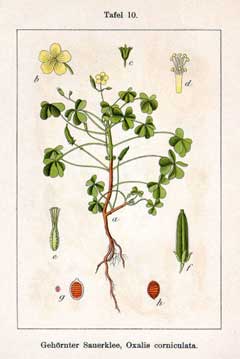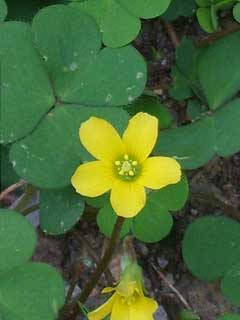 |
|
http://commons.wikimedia.org/wiki/File:Oxalis_corniculata_Sturm10.jpg |
 |
| http://commons.wikimedia.org/wiki/User:Dalgial |
Translate this page:
Summary
Physical Characteristics

 Oxalis corniculata is a ANNUAL/PERENNIAL growing to 0.1 m (0ft 4in) by 0.3 m (1ft).
Oxalis corniculata is a ANNUAL/PERENNIAL growing to 0.1 m (0ft 4in) by 0.3 m (1ft).
See above for USDA hardiness. It is hardy to UK zone 5 and is not frost tender. It is in flower from June to September. The species is hermaphrodite (has both male and female organs) and is pollinated by Insects. The plant is self-fertile.
Suitable for: light (sandy), medium (loamy) and heavy (clay) soils and prefers well-drained soil. Suitable pH: mildly acid, neutral and basic (mildly alkaline) soils. It cannot grow in the shade. It prefers dry or moist soil.
UK Hardiness Map
US Hardiness Map
Synonyms
O. repens.
Plant Habitats
Cultivated Beds;
Edible Uses
Edible Parts: Flowers Leaves
Edible Uses: Gum
Leaves - raw or cooked[2, 46, 61, 105]. Added to salads, cooked as a potherb with other milder flavoured greens or used to give a sour flavour to other foods[183]. The leaves are available all year round unless the winter is very cold, they have a pleasantly sour taste[114], but are very small and fiddly to harvest[K]. The leaves contain about 86% water, 2.3% protein, 0.8% fat, 8.2% carbohydrate, 150mg calcium, 78mg phosphorus, 8mg iron, 0.6mg niacin, 78mg vitamin C, 6050µg beta carotene[173]. The leaves contain between 7 - 12% oxalate[218]. Use in moderation, see notes at top of sheet, Flowers - raw. A nice acid flavour and a pleasant addition to the salad bowl[K].
References More on Edible Uses
Medicinal Uses
Plants For A Future can not take any responsibility for any adverse effects from the use of plants. Always seek advice from a professional before using a plant medicinally.
Anthelmintic Antiphlogistic Antiscorbutic Astringent Depurative Diuretic Emmenagogue Febrifuge
Lithontripic Miscellany Stomachic Styptic Urinary Vitamin C
The whole plant is anthelmintic, antiphlogistic, astringent, depurative, diuretic, emmenagogue, febrifuge, lithontripic, stomachic and styptic[147, 178, 218, 240]. It is used in the treatment of influenza, fever, urinary tract infections, enteritis, diarrhoea, traumatic injuries, sprains and poisonous snake bites[147]. The juice of the plant, mixed with butter, is applied to muscular swellings, boils and pimples[272]. An infusion can be used as a wash to rid children of hookworms[257]. The plant is a good source of vitamin C and is used as an antiscorbutic in the treatment of scurvy[240]. The leaves are used as an antidote to poisoning by the seeds of Datura spp, arsenic and mercury[218]. The leaf juice is applied to insect bites, burns and skin eruptions[218]. It has an antibacterial activity[218].
References More on Medicinal Uses
The Bookshop: Edible Plant Books
Our Latest books on Perennial Plants For Food Forests and Permaculture Gardens in paperback or digital formats.

Edible Tropical Plants
Food Forest Plants for Hotter Conditions: 250+ Plants For Tropical Food Forests & Permaculture Gardens.
More

Edible Temperate Plants
Plants for Your Food Forest: 500 Plants for Temperate Food Forests & Permaculture Gardens.
More

More Books
PFAF have eight books available in paperback and digital formats. Browse the shop for more information.
Shop Now
Other Uses
Dye Gum Miscellany
A slimy substance collects in the mouth when the leaves are chewed, this is used by magicians to protect the mouth when they eat glass[114]. Yellow, orange and red to brown dyes are obtained from the flowers[168]. The boiled whole plant yields a yellow dye[257].
Special Uses
References More on Other Uses
Cultivation details
A very easily grown plant, succeeding in a sandy soil in a warm dry position[1]. It prefers dry open habitats[50]. Spreading rapidly by seed and underground bulbils, this species can quickly become a nuisance, it is a common weed of pot plants in nurseries[200].
References Carbon Farming Information and Carbon Sequestration Information
Temperature Converter
Type a value in the Celsius field to convert the value to Fahrenheit:
Fahrenheit:
The PFAF Bookshop
Plants For A Future have a number of books available in paperback and digital form. Book titles include Edible Plants, Edible Perennials, Edible Trees,Edible Shrubs, Woodland Gardening, and Temperate Food Forest Plants. Our new book is Food Forest Plants For Hotter Conditions (Tropical and Sub-Tropical).
Shop Now
Plant Propagation
Seed - best sown as soon as ripe in a cold frame. This plant does not need any encouragement.
Other Names
If available other names are mentioned here
Native Range
TEMPERATE ASIA: China (Anhui Sheng, Fujian Sheng, Gansu Sheng, Guangdong Sheng, Guangxi Zhuangzu Zizhiqu, Guizhou Sheng, Hainan Sheng, Hebei Sheng, Henan Sheng, Hubei Sheng, Hunan Sheng, Jiangsu Sheng, Jiangxi Sheng, Liaoning Sheng, Nei Mongol Zizhiqu, Qinghai Sheng, Shaanxi Sheng, Shandong Sheng, Shanxi Sheng, Sichuan Sheng, Xizang Zizhiqu, Yunnan Sheng, Zhejiang Sheng), Japan, Korea, South TROPICAL ASIA: Bhutan, India, Nepal, Pakistan, Myanmar, Thailand, Malaysia
Weed Potential
Right plant wrong place. We are currently updating this section.
Please note that a plant may be invasive in one area but may not in your area so it's worth checking.
Conservation Status
IUCN Red List of Threatened Plants Status :

Growth: S = slow M = medium F = fast. Soil: L = light (sandy) M = medium H = heavy (clay). pH: A = acid N = neutral B = basic (alkaline). Shade: F = full shade S = semi-shade N = no shade. Moisture: D = dry M = Moist We = wet Wa = water.
Now available:
Food Forest Plants for Mediterranean Conditions
350+ Perennial Plants For Mediterranean and Drier Food Forests and Permaculture Gardens.
[Paperback and eBook]
This is the third in Plants For A Future's series of plant guides for food forests tailored to
specific climate zones. Following volumes on temperate and tropical ecosystems, this book focuses
on species suited to Mediterranean conditions—regions with hot, dry summers and cool, wet winters,
often facing the added challenge of climate change.
Read More
Expert comment
Author
L.
Botanical References
17200
Links / References
For a list of references used on this page please go here
Readers comment